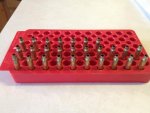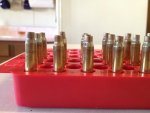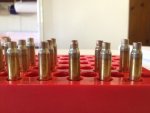So I have a lot of brass that has multiple loadings on it and Im starting to see some neck splits and accuracy is beginning to fall off.
I decided I would try my hand at quick and dirty annealing. I used a drill, deep socket, a bolt and nut and a propane torch. I decided to do a 10 count on the .308 brass (FC) and a 6 count on the .223 (RP)
Does this look like the right amount of heat to you guys? The .223 looks good to me, but the .308 looks like its not enough. If I keep it in the heat any longer, the mouth turns cherry red though.
The left .308 has been annealed, the right has not. Same with the .223 cases.

Mind you this is just an off the hip experiement at this point, so I havent invested in thermo-paint or anything. I was more curious as to if it was actually going to be effective in this setup or not.
Thanks!
I decided I would try my hand at quick and dirty annealing. I used a drill, deep socket, a bolt and nut and a propane torch. I decided to do a 10 count on the .308 brass (FC) and a 6 count on the .223 (RP)
Does this look like the right amount of heat to you guys? The .223 looks good to me, but the .308 looks like its not enough. If I keep it in the heat any longer, the mouth turns cherry red though.
The left .308 has been annealed, the right has not. Same with the .223 cases.

Mind you this is just an off the hip experiement at this point, so I havent invested in thermo-paint or anything. I was more curious as to if it was actually going to be effective in this setup or not.
Thanks!
Last edited:




